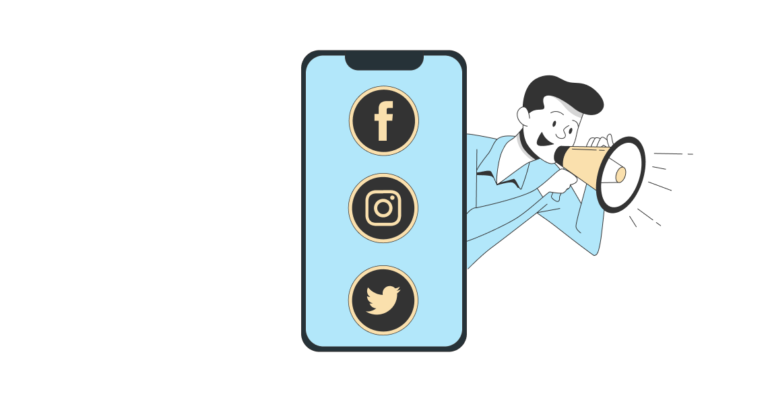Are you doing digital marketing for your brand and clients? Most people will answer “yes” to this question. And the reason is clear: the internet is everywhere; it’s powerful, and it’s here to stay. In April 2022, there were $5 billion internet users, which amounts to a penetration level of 63%. This means brands can reach half the people in the world through digital marketing.
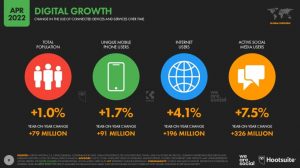

Source: datareportal.com
But does that make your job easier? No. Digital marketing is evolving rapidly. Marketing methods that worked brilliantly earlier like advertising are losing steam. Newer methods like chatbots and influencer marketing are gaining ground. So, marketers need to stay abreast of the latest changes in digital marketing methods and technologies.
When it comes to digital marketing, well-planned is well-executed. Marketers who actively plan their marketing programs get 356% more returns than those who don’t, according to CoSchedule’s survey of 3,217 B2B and B2C marketers.
That’s why we’ve identified 7 disruptive digital marketing strategies for 2024. This post will explain the best way of leveraging each strategy. You will also read about contemporary brands that have mastered each strategy.
If you get into a rut with your marketing campaigns, you’re bound to lose customers. Customers today are discerning and don’t mind shifting their loyalty to brands that fulfill their expectations.
Since we don’t want you to waste time, money, and effort by investing in just any marketing tactic, we’ve identified the top 7 digital marketing tactics that are expected to work in 2024.
Here they are:
- Influencer marketing
- Mobile-first marketing
- Marketing automation
- Multi-platform content strategy
- Brand storytelling
- Chatbot marketing
- Voice/visual search
Digital Marketing Tactics to Use in 2024:
1. Influencer Marketing
Influencers are people or other living or non-living entities that are trusted by a group of people normally called “followers.” Influencer marketing means collaborating with influencers to endorse your brand, products, or services. In return, you offer compensation in the form of money, free products, exclusive deals, or other benefits.
A study found that at least 66% of people don’t trust brands as much as they used to. Similarly, consumers loathe advertisements. 74% of people either use ad blockers, change their media habits to avoid commercials, or pay for ad-free streaming services.
All forms of blatant self-promotion are being shunned by audiences. In such a scenario, how can brands reach consumers and earn their trust?
The answer is influencers. 63% of people trust recommendations made by influencers more than what brands are saying about themselves or in commercials. Their relatability outweighed the popularity of celebrities.
Influencers are not only lending credibility to brands, but they are also actually driving purchase decisions. 58% of people bought a product after an influencer recommended it.
You may be surprised to learn that influencers with small follower communities (nano- and micro-influencers) may promote your brand without expecting any monetary compensation. They are sometimes more than happy with the exposure and experience that the association provides or just free products.
Influencer marketing contains a number of sub-modules, such as influencer discovery, relationship and campaign management, and ROI measurement and analytics. Though the majority of brands do influencer marketing in-house, influencer marketing platforms can provide end-to-end solutions at affordable rates.
To give you an example of how brands use influencer marketing to grow their business, check out the Instagram feed of the clothing brand, n:philanthropy. They partnered with Mrs.Arizona, Jolene Goring, who is an Instagram influencer to spread the word about their joggers and tees.
Note how Jolene highlights the societal causes that the brand endorses, such as empathy towards cancer patients and animals. This helps humanise the brand and enhance their trust quotient.
2. Mobile-First Marketing
Mobile-first marketing is essential for every progressive brand. Salesforce’s State of Marketing report states that 68% of companies have included it in their overall marketing plan. Since consumers are hooked to their mobiles, brands and marketers must follow the cue and make mobile marketing a priority.
Marketing is governed by customer expectations. If consumers expect brands to give them a consistent and seamless experience across devices, brands can’t ignore the mandate. Google’s 2019 survey explains why marketers need a mobile-first approach:
- 60% of smartphone users have contacted a business directly from the SERPs.
- 59% of respondents favour brands that allow them to shop via mobile.
- 58% of people like companies whose mobile sites and apps remember their past online behaviour and history.
Heightened consumer demands and evolving buying patterns demand that businesses should invest in mobile sites and apps. In this way, you can offer more quick, personalised, and device-agnostic service to your customers.
A mobile site is a basic requirement if you want to keep in touch with your on-the-go customers. Responsive website layouts look good on all screen sizes and resolutions. The “less is more” approach works best for mobile sites. Text-heavy pages intimidate users. You should also use white space liberally.
The taxi-hailing company, Lyft, has a minimalistic website. The header bar is uncluttered with just four main menu options. Below the banner is a clear CTA for drivers who want to join the Lyft network. The footer contains buttons to download the app. The navigation is so intuitive that even first-time users will feel at home instantly.
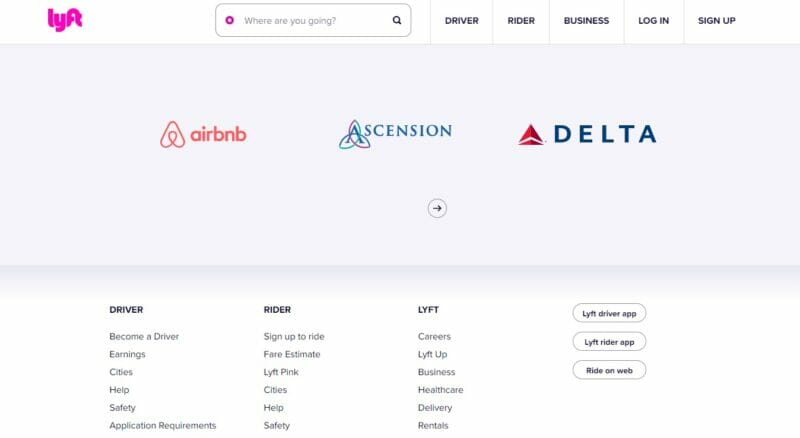

Source: lyft.com
Mobile-first marketing doesn’t end with responsive design. You need a start-to-finish mobile-optimised perspective while creating your marketing plan. Just like your website content, your blog posts, emails, ads, and social posts should be created keeping mobile in mind.
Videos and visuals impress mobile users greatly. They also keep viewers engrossed for longer and create a far greater impact than plain text content. You can use a blend of audio, video, and text content to appeal to different user segments and platforms.
Mobile apps deserve a special mention for their proven ability to drive sales. In Q3 of 2019, global users spent USD 23 billion via mobile apps. In 2019 alone, 32% of app visitors returned to an app they liked 11 times or more.
A one-time investment in creating an app keeps giving returns by improving your sales and customer retention rates. Your app’s interface should be super-friendly and the onboarding process should be painless. Bear in mind that 29% of app users abandon an app if they don’t find it valuable.
3. Marketing Automation
In simple words, marketing automation means automating repetitive tasks so that tools can perform the tasks instead of humans. It covers a wide array of marketing activities, from sending triggered emails to your website visitors to using AI chatbots for solving customer queries.
Marketing automation has a number of benefits. If used for sales lead generation and lead nurturing, it can make your sales team more productive. There are tools that can deliver discount coupons to customers that are near conversion. They can retarget lost site visitors with offers that are based on these people’s buying or browsing histories.
Sales prospecting tools can segment and score your contacts and leads. Your sales teams get more qualified and sales-ready leads. Such tools can decipher patterns that the human eye can miss.
The hardest part of marketing is staying consistent. Scheduling tools can handle routine tasks such as social media posting, sending welcome emails, and allocating tasks to teammates. 64% of marketing professionals report that their marketing automation is somewhat successful at helping them to achieve their most important goals.
Companies are using marketing automation in varied ways, as you can see in the chart below.
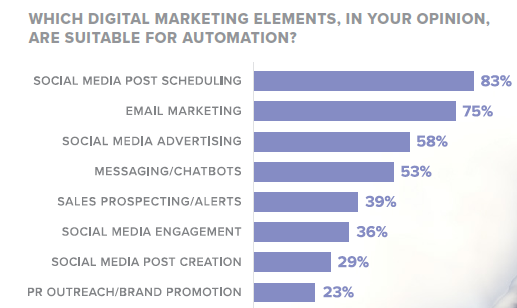

Source: resources.industrydive.com
The top three uses of marketing automation are in social media post scheduling, email marketing, and social media advertising. Activities like post creation require creativity so they aren’t as widely automated. On the other hand, messaging and chatbots, which call for some degree of sentiment analysis, have also become ripe for marketing automation.
Ecommerce store, Target, uses automation superbly. They gather information about casual site visitors. Then, they send an app download link by SMS alerts. Once a person installs and opens their app, they keep emailing personalised offers. After the first purchase, they pop-up a product review window for buyers to rate their experience in-app and in the Play store.
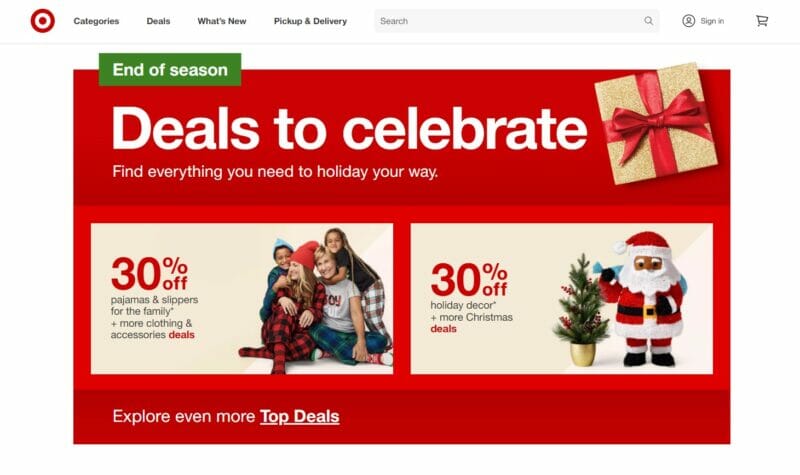

Source: target.com
4. Multi-Platform Content Strategy
If you’re hoping to get visibility for your brand, you need to be active on all leading platforms that cater to your consumers. You should also have a presence on the channels from where your top competitors get most of their traffic.
Though a multi-pronged content plan may seem overwhelming at first, it becomes easier as time goes by, when one channel feeds the other. You will have multiple touchpoints to communicate with customers and gather insights about them.
You need to modulate your online and offline content offerings to reflect a cohesive brand personality. Your print material, newsletters, social content, and ad copy need to be in harmony.
Nike has perfected the art and science behind a multi-platform content strategy. They have numerous social profiles, with dedicated accounts for football fans and fitness freaks. Their fan pages are among the top 10 on Facebook. Accounts for different geographies contain localised content and feature local celebrities.
5. Brand Storytelling
Humans buy from humans. Your brand can’t afford to remain a faceless entity in this era of automation. Brand storytelling weaves together a brand, its values, and products to create a narrative that tugs at their customers’ heartstrings. Ultimately, it creates a bond forged in trust between a brand and its customers and fosters loyalty and repeat sales.
Talking about the journey that shapes your brand will make your brand stand out among your peers. You can put the spotlight on your unique proposition without sounding promotional. If a brand is transparent about its value system, instead of touting its products, they can cultivate trust more effectively.
It’s important to come up with creative ways to tell your brand’s story. The key is to be authentic and deliver a consistent message to your viewers.
Burt’s Bees produces all-natural cosmetics. They create mini-documentaries about the man behind the brand, Burt, who is a nature enthusiast and an advocate of a rural, organic lifestyle. The aim is to show that Burt’s products are honest and reflect his ideology.
Their Burtism series features Burt’s wise teachings. The video below lets customers take a look inside Burt’s log cabin.
6. Chatbot Marketing
Chatbots are computer programs that are programmed to converse and react like humans. Chatbots can improve customer experiences, and they have a vast, untapped marketing potential too.
Facebook Messenger chatbots can be used to create drip campaigns and close deals effectively. Companies are increasingly using messenger applications with their own chatbots.
Chatbots are loved for their on-demand and always-on services. They boost user experience by providing quick, personalised responses to customer queries. Advanced bots are equipped with voice and face recognition abilities so that users don’t have to lift a finger to type questions.
Bots can gather vital customer data and insights that can be utilised by sales and marketing teams to pre-qualify leads. Plus, bots significantly cut down on labour overhead as a single bot can handle the workload of many sales reps. This is perhaps why 70% of corporations have said that chatbots have contributed to their sales being boosted.
Marketers are using bots in exciting ways. Pizza Hut and Starbucks allow customers to place orders via voice commands to bots. Spotify’s bot creates playlists with your favourite tracks. Mastercard’s bot can calculate how much you spent on eating out last month. Sephora’s bot lets you ace your makeup game by giving tutorials.
Disney cult favourite, Zootopia, featured a spunky protagonist, Judy Hopps. Disney made a Zootopia-inspired bot on their Facebook Messenger where kids get to talk with Judy. Needless to say, youngsters were enthralled by the experience.
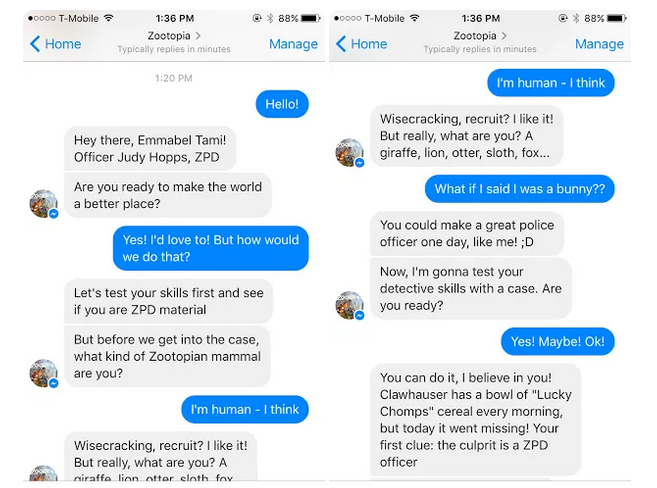

Source: disneyexaminer.com
7. Voice/Visual Search
Your business should be equipped to handle voice and search queries that will make up a big chunk of all mobile queries in 2024. Foreseeing the trend, Google launched its Search by Photo option for visual search and Google Assistant for voice search. Every forward-thinking brand needs to embrace the trend.
Consumers love the hands-free experience that voice search provides. They especially enjoy the freedom of multitasking as they give voice commands to search for favorite songs, make bookings at restaurants, or set alarms. In 2023, 43% of people used voice search at least once a month on any device.


Source: insiderintelligence.com
If you enable onsite visual tagging, you can catch the attention of crawlers when a searcher uploads an image as a Google search query. You can facilitate a seamless shopping experience as more and more of visual searches are performed on mobiles. You can enhance your shoppers’ in-store experience by providing prices, reviews, and locations of items in response to voice queries.
After Google Lens, Pinterest launched a visual search tool, Lens, to search themes and pictures related to pictures uploaded from smartphones or Pins. Now, they have added Shoppable Pins that provide product information and a direct link to the website to purchase the product.
Conclusion
Marketing has an ever-evolving landscape. You need to be at the top of trends if you want to beat the competition and stand out in the crowd. These revolutionary digital marketing tactics are backed by expert insights and examples for inspiration. Pick the methods that match your budget and get started.


